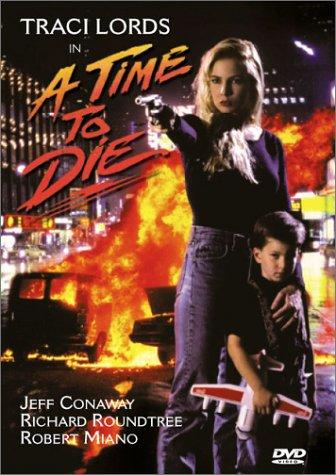Matty probes a so-so PM Entertainment flick that’s buoyed by a great turn from its leading lady.
Lensed in spring ‘91 — just before co-star Jeff Conaway was sentenced to sixty days house arrest after hitting a cyclist while drunk driving, fact fans — A TIME TO DIE managed to bag cinema space in a couple of Los Angeles fleapits ahead of its U.S. video release at the back end of the year, on 5th December. Though unnoticed during its brief theatrical run, in the weeks either side of A Time to Die’s cassette bow the film received a surprising amount of coverage in the mainstream press, mostly as a footnote in misogynistic write-ups about Traci Lords.
At the time, Lords had finally established herself as a ‘legitimate’ actress thanks to excellent turns in Jim Wynorski’s Not of This Earth (1988) and John Waters’ Cry-Baby (1990), and guest spots on TV shows Married… With Children and MacGyver. Certain hacks, however, were still obsessed with her porn background and referenced it in anything remotely Lords-related. Even now-revered pundit Joe Bob Briggs would crudely lament how the starlet — who, lest we forget, was underage for the vast majority of her XXX work — didn’t ‘get naked’ anymore, fostering a belief that every new Lords pic ought to rest on her tits and tits alone. Because hey, once a porn star, always a porn star, right? Such was the case with A Time to Die. The bulk of the notices this PM Entertainment production gathered were more preoccupied with the lack of nudity in Lords and Conaway’s love scene than they were with anything else — which, of course, misses the point of the film entirely.
Despite being marketed in PM’s increasingly bombastic manner (guns and fire feature prominently on its key art [1]), A Time to Die sidesteps the expected action movie licks. There’s a bit of shooting and a stirring finale when its two initially jarring strands — domestic drama and suspenser — collide with an unexpected degree of harmony; but, by and large, it’s a performance-driven flick closer to the kind of gritty, name-led thrillers that the company churned out before they found their wilder groove across Cyber Tracker (1994) et al (cf. Wings Hauser/Coldfire (1990), Dan Haggerty/Repo Jake (1990)). The first of three vehicles she’d topline for PM, Lords was instrumental in A Time to Die’s development and had the film tailored to a brief of her design when the shingle’s bigwigs, Richard Pepin and Joseph Merhi, asked what it’d take to get her under contract.
“I said I wanted to play someone a little older because I’d been playing teen roles,” stated Lords in one of the few even-handed newspaper pieces of the period. “I wanted to play a strong woman, an independent woman, a woman of the ‘90s, who goes through all this adversity and is used by people — and then she gets her revenge in the end! I’m very proud of the film and I’m very proud I got to do it.” [2]
And so she should be, at least in terms of her own contribution. Then twenty-two, Lords is excellent as Jackie, a shutterbug working for the LAPD. Introduced as a ballsy and mischievous nuisance, Jackie hides heartache behind her smirk and defiant attitude. A fashion photographer by trade, her unwanted post with the bizzies is the result of a community service order following a false drug charge trumped up by a bent officer (Robert Miano) which, in a further twist, caused the young mother to lose custody of her five year-old son. Despite the family stuff coming across as exhaustingly schmaltzy — a trait worsened by several horrifically sugary cues by regular PM composer Louis Febré — Jackie is a fascinating part, and Lords injects director Charles T. Kanganis’ self-penned script with a verisimilitude that transcends the cheesiness. Indeed, based upon Lords’ above-noted comments, there’s a powerful feeling of catharsis to her hugely effective portrayal too. As the involving — if plodding and awkwardly structured — A Time to Die settles into revenge territory at the forty minute mark (Jackie photos Miano’s crooked cop in a compromising position, and he unleashes hell trying to get her snaps before the inevitable comeuppance), there’s a sense that Lords is not only fighting back in character but fighting back metaphorically as well.
Against those convinced that her best work was done sans clothes.
And, maybe, against those who exploited her in real life.
It’s just a shame that the rest of the film never quite matches her.
Lords, PM and Kanganis reunited for the superior Intent to Kill (1992), and Lords concluded her Pepin and Merhi tenure with Ice in 1994.
USA ● 1991 ● Thriller ● 89mins
Traci Lords, Jeff Conaway, Robert Miano ● Wri./Dir. Charles T. Kanganis

[1] As does a completely different kid to the one who appears in the actual film.
[2] Relying on her Guardian Angel by John Wooley, Tulsa World, 25th October 1991.

